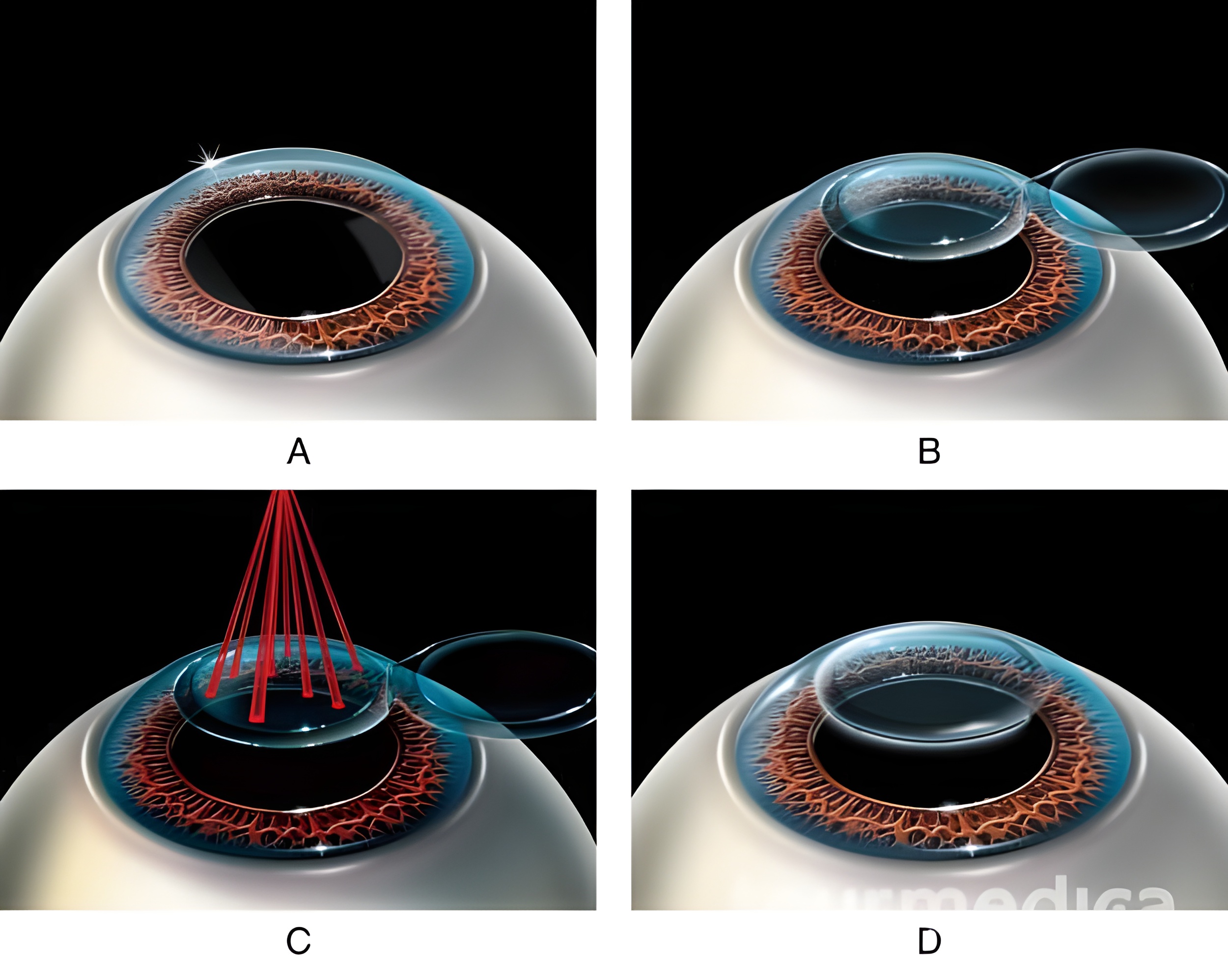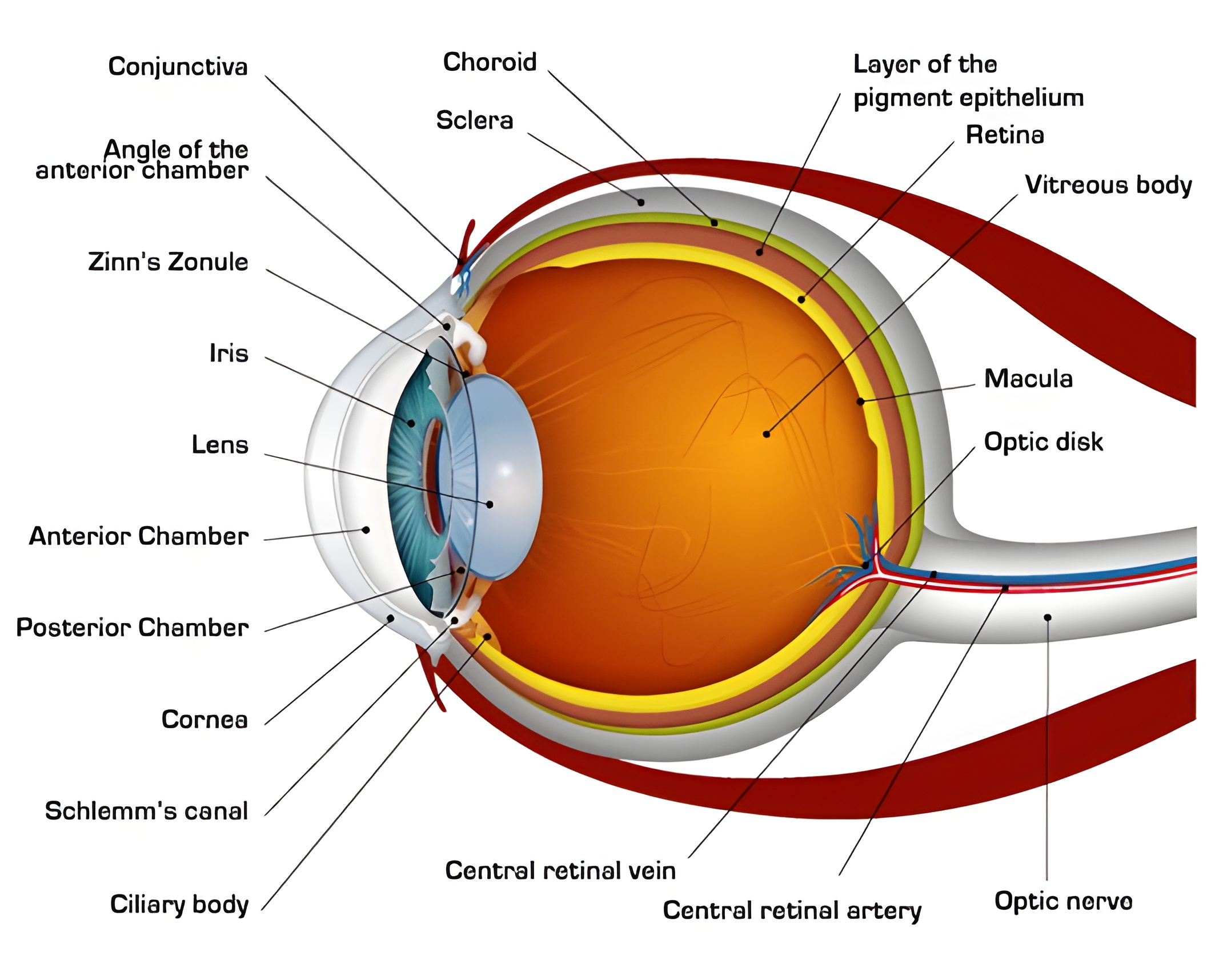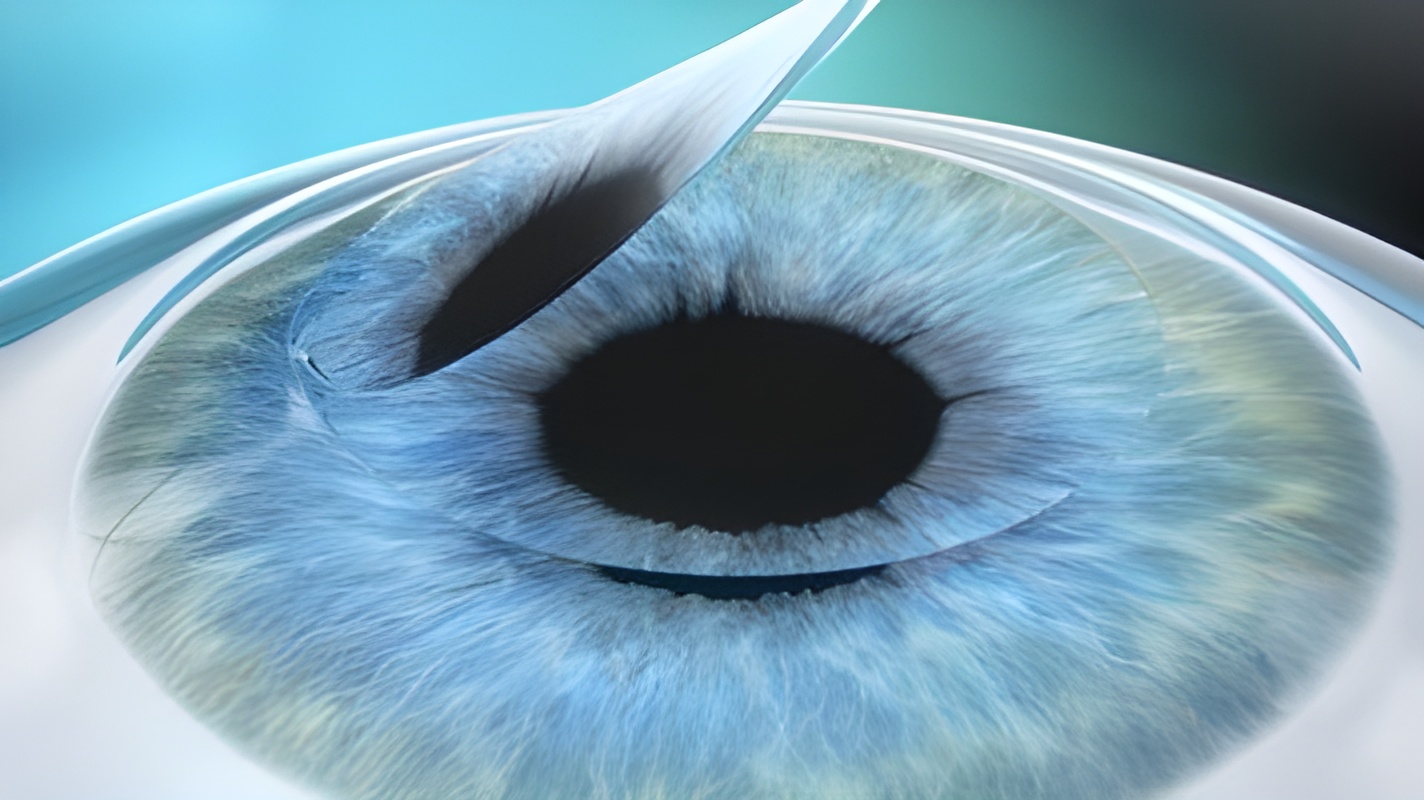LASIK (laser-assisted in situ keratomileusis) laser vision correction is the most commonly performed laser eye surgery to treat myopia (nearsightedness), hyperopia (farsightedness) and astigmatism.
As with other types of laser refractive surgery, the LASIK procedure reshapes the front surface (cornea) of the eye, allowing light entering the eye to focus on the retina without glasses or contact lenses.
Usually, the LASIK procedure is painless. Treatment of both eyes takes only about 15 minutes. Vision improves immediately and is often stabilized in as little as 24 hours.
Read more about laser vision correction
LASIK procedure
The LASIK procedure consists of three main steps:
- Using a mechanical surgical instrument called a microkeratome or femtosecond laser, a thin circular flap is created in the cornea. The surgeon then pulls this flap back to access the main corneal substance (stroma)).
- The excimer laser is used to reshape the corneal stroma. This highly specialized laser uses a beam of cold ultraviolet light to remove ("ablate") a microscopic amount of tissue from the cornea to reshape it and focus light more precisely onto the retina to improve vision.
- The corneal flap is placed where it adheres without sutures to the corneal stroma.
What to expect
Before LASIK vision correction surgery
Your ophthalmologist will perform a thorough eye examination to determine if LASIK vision correction is right for you.
During this exam, your doctor will examine the surface of your eye to make sure there is no risk of dry eye syndrome after LASIK.
Using an automated tool called a corneal topographer, a detailed dot map of your corneal shape will be created. In addition, an additional measurement called corneal wavefront analysis may be performed to achieve the best possible LASIK vision correction result.
You should stop wearing contact lenses for the time recommended by your optometrist (usually at least two weeks before the LASIK procedure). This is important because wearing contact lenses can change the natural shape of the cornea and affect the outcome of the procedure.
During the LASIK procedure
Immediately before LASIK surgery, numbing eye drops are applied to your eyes to prevent discomfort during the procedure. Your ophthalmologist may also give you some medication to help you relax.
Your eye will be positioned under the laser and your eyelids will be held open with an instrument called an eyelid spreader.
A vacuum ring is placed on the front of the eye to prevent eye movements or loss of contact that could affect the quality of the corneal flap.
After the corneal flap is created, the surgeon will use a computer to adjust the excimer laser according to specific instructions. You will be asked to look at the directional light for a short time while the doctor observes through a microscope how the laser sends pulses of light to the cornea.
The laser light pulses painlessly, reshaping the cornea, but you may feel some pressure on your eye. You will also hear a continuous clicking sound while the laser is working. The laser treatment itself only takes about one minute.

After LASIK procedure
After LASIK surgery is complete, your surgeon will let you rest for a while. You may feel a temporary burning or itching sensation immediately after the procedure.
Choose a clinic for laser vision correction
You can go home after a short postoperative checkup. (You cannot drive after LASIK until your surgeon examines you the next day and confirms that your uncorrected vision meets legal driving standards.)
Immediately after surgery, you should expect some blurring and blurring of vision, but most people's vision improves immediately and stabilizes within a few days.
It is possible that the next day you can go to work, but many surgeons advise resting for a couple of days instead.
Generally, the day after surgery, you return to your ophthalmologist or the surgeon who performed the LASIK procedure.
During this visit, the doctor will check your eyesight to make sure you are eligible to drive without glasses or contact lenses.
Follow the surgeon's instructions and take all prescribed medications. Also, do not rub your eyes, as there is a small chance that this may dislodge the flap until it heals and attaches to the underlying cornea.
Long-term effects of LASIK surgery
Laser eye surgery provides many benefits and can greatly improve your quality of life. Most people achieve visual acuity of 20/20 or better (6/6) after surgery, but results vary from person to person.
You may still have to wear glasses or contact lenses after laser vision correction, although the level of correction indicated on your prescription will usually be much lower than before.
If you have a small residual refractive error after LASIK vision correction and want sharper vision for certain activities, such as driving at night, prescription lenses with anti-reflective coatings are helpful in most cases.
If you become sensitive to sunlight after the LASIK procedure, ask your optometrist to prescribe glasses with photochromic lenses.
Although the LASIK procedure has an excellent safety record, complications are possible, which can include infection or nighttime glare (starbursts or halos, which are most noticeable when you look at light at night, such as while driving).
A small percentage of people need an "additional correction" procedure with LASIK a few months after the initial LASIK surgery to achieve acceptable visual acuity.
And you will still need reading glasses once you reach age 40, due to the natural age-related loss of near vision, called presbyopia.

Questions for doctors.
Laser vision correction may be the right path for you to a world without glasses or contact lenses. But like any surgical procedure, laser correction has some risks. You must be confident in your surgeon and the right laser correction procedure.
Check out some of the "tough" questions to ask your laser surgeon before you decide to go in for laser correction.
Make sure your future laser surgeon is sincere. Ask about his qualifications and experience.
The qualifications of the surgeon are of great importance in the results of LASIK correction. You can become an experienced refractive surgeon after at least 5 years in the field.
Read more about cataract treatment
Find out which refractive procedures are most often performed at this clinic?
A qualified surgeon should perform about 500-800 such operations in the last year.
Ask your surgeon about the success rate. Find out what proportion of patients after LASIK correction see 60% and what proportion see 100%.
According to statistics from the U.S. Quality Standards Advisory Committee (QSAC), on average, 90% of patients get vision above 60%, and 65% of patients get 100% or better. Doubt if your surgeon gives numbers much better than those given, it doesn't match the world statistics, ask for proof. Ask, for example, if this data has been published and where can you see it? A surgeon who can be trusted with his eyes will usually have his results analyzed and published in the international press.
The right surgeon not only performs surgery, high professionalism requires honesty and critical evaluation of the results of their work, so your laser surgeon will be willing to share this information with you.
Complications
Ask about the incidence of complications within the next six (6) months after LASIK. International statistics say 3%, which is not much, but it does happen. If your future doctor claims "flawless" results, you should question the objectivity of these results.
Ask about the number of patients who have been denied LASIK correction.
Not all patients can be safely corrected with LASIK and receive good results. There are many factors: the degree of refractive error, thickness and shape of the cornea, age, and presence of concomitant diseases. The number of patients rejected for laser correction varies from center to center, but is definitely more than "0".
In ophthalmology clinics the refusal rate for laser correction is about 10%. Not only the safety level of correction is taken into consideration, but also the expected quality of vision after correction.
Thirty years of accumulated world experience in laser correction and modern equipment have made it possible to develop clinical criteria for prognosticating vision quality results after laser correction. Today the quality of vision after laser correction can and should be predicted.

Ask your surgeon about the equipment.
Laser correction can only be performed in clinics with the highest category. This means that the medical center has 90-100% confirmed the requirements of the national standard in health care. The required minimum for the clinic is at least 3 years.
Ask if LASIK is right for you?
Your doctor will only be able to answer this question after a comprehensive examination.
The minimum age recommended for LASIK is 18 years old and you must not have any contraindications to correction for your general health.
You should be cautious if your doctor is not interested in your overall health condition, because there are a number of chronic diseases which increase the risk of complications after laser correction, and some diseases are relative contraindications for laser correction. Your medical condition should be discussed in detail with your laser surgeon.
Your vision should be stable for at least the last 12 months.
Other factors that are taken into consideration:
- the degree of refractive error,
- Corneal thickness before and after correction (at least 500 microns BEFORE and at least 300 microns AFTER LASIK (not including the flap thickness)),
- Corneal configuration and curvature (no less than 36 Diopters and no more than 49 Diopters after correction),
- the depth of the anterior chamber of the eye,
- the width of the pupil at twilight (together with the depth of the anterior chamber affects image sharpness and light scattering in twilight).
All these factors should be discussed with you when you decide about the possibility of laser correction, because they all influence the safety of correction and the quality of vision you will get after the correction.
If your indications are not a good candidate for laser correction, you will be offered an alternative method that may work better for you.
The clinic should have a full range of modern alternative methods of LASIK vision correction - phakic lens implantation, refractive lens replacement, astigmatology.
If the clinic does not have the full range of alternatives, it means that you have not come to the clinic professionally enough and you will not get a solution in your best interest.
Find out how your vision recovery is going.
LASIK correction is an outpatient procedure. Your doctor will describe the rehabilitation process and recommended restriction regime for this period. Most patients experience minimal discomfort, which disappears within the first few hours after correction. The next day your vision may improve up to 90-100%. But in the following days fluctuations in visual acuity and increased sensitivity to bright light are possible.
Your doctor will explain in detail how to take care of your eyes during your LASIK rehabilitation. He will recommend protective and preventive measures, as well as a medication regimen. The recovery process depends on each patient's body, but most patients can start working normally the day after the correction.
Choose a clinic where you will be able to get in touch with your doctor during the first 24 hours after the operation if necessary, where you will be guaranteed the possibility of a second consultation. Do not choose a clinic where the surgeon is not available to the patient because of his absence from the country (visiting doctor), where it is difficult or impossible to get to a consultation with the surgeon after the laser correction and where there is an additional fee for a second consultation.
Ask about the cost of LASIK correction.
Even in one ophthalmology center, the cost of laser correction can vary, depending on the complexity.
Laser correction is an expensive procedure not only for the patient, but also for the clinic. The cost of the laser and the maintenance of its impeccable technical condition is a large financial expense for the clinic. However, this is what ensures the high quality of the correction itself. Cheap correction is always a cause for caution, because there is no such thing as a good laser correction and a cheap one at the same time.
What is included in the cost of correction?
Find out if this includes the cost of post-operative follow-up and for how long, and if there are complications, are there additional fees for additional examinations and longer follow-up?
If the physician considers it medically necessary to continue monitoring the patient, it will be carried out as part of the contract at no additional charge.
How long after LASIK are patients followed up at the clinic? Do patients have follow-up examinations one year after the procedure? How are the results of correction monitored?
Within a month after the correction the patient should be examined several times by the doctor. It is also desirable to examine the patient 1 year after the laser correction. The clinic should keep a record of its results and provide the patient with data on its results.
Laser correction really does offer the possibility of almost magical vision improvement in a matter of minutes. It can change your life for the better.
MEDICAL DISCLAIMERThis content is for informational and educational purposes only. It is not intended to provide medical advice or to be a substitute for such advice or treatment by a personal physician. All readers of this material are advised to consult their own physicians or qualified health care professionals. UAmedTOURS is not responsible for the possible health consequences to any person or persons reading or following the information contained in this educational content. All readers of this content, especially those who take prescription or over-the-counter medications, should consult their physicians before making any changes in their diet, lifestyle, taking pills, or other facts that may affect your physical and psychological health.









